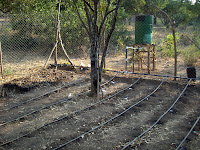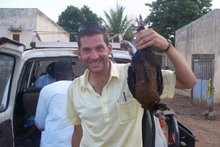First off, my cell phone number will change April 22nd, as the national phone system didn’t look very far into the future and plan for an increase in numbers. They are adding an 8 to all cell phone numbers and a 2 to all land lines.
My new cell phone number: (505) 8409-0366.
Sorry for the long lapse, but I have been traveling quite a bit for workshops, presentations, Easter Week, and, technology fairs. Needless to say, I haven’t been in my site very much. In Spanish we would say I am vago, or always traveling. This was a good thing as all of these workshops helped increase my knowledge on appropriate technology and community development.
The first workshop that I attended at the beginning of the month included an agro-business presentation in Granada-a very pretty city located next to the largest lake in Nicaragua (also the only freshwater lake where you can find the only freshwater sharks in the world!!) I brought along a member of my community to come up with new project ideas for our community. After the workshop, I returned for a couple of days and went back to the capital, Managua, to pick-up three friends at the airport-Greg McGrath, Lando Roberts, and Charles Fisher. They came down here for a week to see what Nicaragua has to offer, and also as an EOS Intl trip to install a Drip Irrigation system in my village. The day after we arrived, we took a 4:00am bus to Jinotega to run a ½ marathon race organized by Peace Corps and a Nica Ag organization. Other than being exhausted, the race was beautiful and the climate was slightly cooler, as the elevation is higher in Jinotega.

The four of us finally returned back to my site and successfully built a drip irrigation system utilizing mostly local materials. We constructed a stand using tree branches to elevate a 50 gallon drum to store water for the irrigation system. Leaving the drum, we connected a series of pipes, filters, valves, and finally the ‘drip tape’ which the water flowed through and leaves in tiny holes spaced 12” apart. What is unique about this system is that it puts water directly to the root of the plant without evaporation which is very prevalent in my HOT and DRY community. After four days of hard work installing this system, we headed off for the beaches of Leon to cool off and volcano boarded down ‘Cerro Negro’ one of the many active volcanoes in Nicaragua. Yes, I said boarded… basically we took a ride out to the base of the volcano in the back of a pickup truck (very Nica style), hiked up the volcano on the back side which was less steep and somewhat of a trail. We then slid down the steep side of the volcano with a thin piece of plywood-similar to a sled. The volcano slope ended with a 45 deg angle, so yes it was quite fast and very exciting!!
I then said my goodbyes to my friends at the airport and headed south to Carazo for a week-long language workshop to improve my Spanish. We were split up into groups of four people each with a facilitator to teach us more Spanish! After the workshop, I traveled all the way up to my site, only to leave two days later for another workshop about Community Banks. Basically a community bank is a group of people in one village, mostly women, who meet twice a month to save money, take out a loan if needed, and make other profits from making and selling foods. This idea of mirco-credit was started from Muhammad Yunus in Bangladesh and is now implemented throughout the world in developing countries. In this workshop, we learned either how to start a bank up in a new community, or how to utilize the bank’s resources if there is one there from an existing PC volunteer.
Finally, last week everybody celebrates Holy Week or Semana Santa in Nicaragua. With our vacation, I decided to hike Nicaragua’s biggest active volcano, San Cristobal. A group of six volunteers all agreed to go on this three day hiking and camping trip. We all headed off for the trip not knowing very much about the volcano as there isn’t very many resources or a National Park System to make maps and trails. We reserved a full day to hike from a sign that we saw on the main road to the base (this sign was the most information we had on the volcano-an arrow pointing in the direction (obvious) and distance), and got very lucky finding a farmer with a beautiful coffee farm nestled at the base of this grand and beautiful volcano to camp at. He also knew of a ‘guide’ who needed to take temperature readings at the top and agreed to lead us up the volcano. We planned on leaving at 5am, before sunrise, but after breakfast and preparing our water, we left at 6am. The total hike took 8 hours including an hour break on the top, a couple of quick sprints across the top lava crater as the sulfur and gasses made it impossible to breath(scary), and finally a jog down the volcano on loose gravel!! The trip was a ranging success and the mission was started… to hike all 16 active volcanoes in Nicaragua before the end of service in two years! I got a head start hiking a volcano when my girlfriend, Chelsy, came down to visit, and just recently the volcano boarding one! Three down 13 to go!
 This past week I was able to catch up with work back in my site. With my community members, we treated 1,000 different tree seeds and planted them in individual plastic bags filled with a good mix of soil, sand, and manure. Now we are taking turns watering the tree nursery twice a day. We also planted onions, peppers, radishes, and tomatoes into the newly installed drip irrigation system and are also adding 30 gallons into the barrel each day! All of these plants are being grown in the school garden, which is a great way to teach children how to grow, offer fresh vegetables for the children’s lunch, and for me to try projects within neutral property-without offending any of the community members.
This past week I was able to catch up with work back in my site. With my community members, we treated 1,000 different tree seeds and planted them in individual plastic bags filled with a good mix of soil, sand, and manure. Now we are taking turns watering the tree nursery twice a day. We also planted onions, peppers, radishes, and tomatoes into the newly installed drip irrigation system and are also adding 30 gallons into the barrel each day! All of these plants are being grown in the school garden, which is a great way to teach children how to grow, offer fresh vegetables for the children’s lunch, and for me to try projects within neutral property-without offending any of the community members. 
Seeds for 1,000 trees…why is that necessary? Well as is the case for most developing nations, deforestation is a very big deal here. People cut down trees for cooking three or more times a day, they cut down trees for building, and finally they cut down trees to sell for wood. On top of this, trees near rivers and wells are used, causing the water to dry up during the dry season. We carefully selected seeds of trees that will provide for good firewood in the future, possible shade for cattle, straight trees for fence posts, dense wood for furniture, or trees to help reforest this area.
Cheers....Wes

4 comments:
Thanks for the update. You're really going to town. We hope to have some similar projects here in Santa Rosa. Keep up the good work.
I'd like to learn more about the appropriate technology projects you've been working with.
Living, Learning, Traveling--Well put, Wes, these have to be just about your three favorite things in life!
I am so proud of all the work you are doing!
Love,
Chels
Thanks for the update, Wes - what an adventure you are having! Sounds like the PC couldn't have a better representative in Nicaragua. I talked to Greg after he got back, I think - he's going to find someone here at STA to write a grant request to our Tithe Grant committee. Best wishes!
Post a Comment